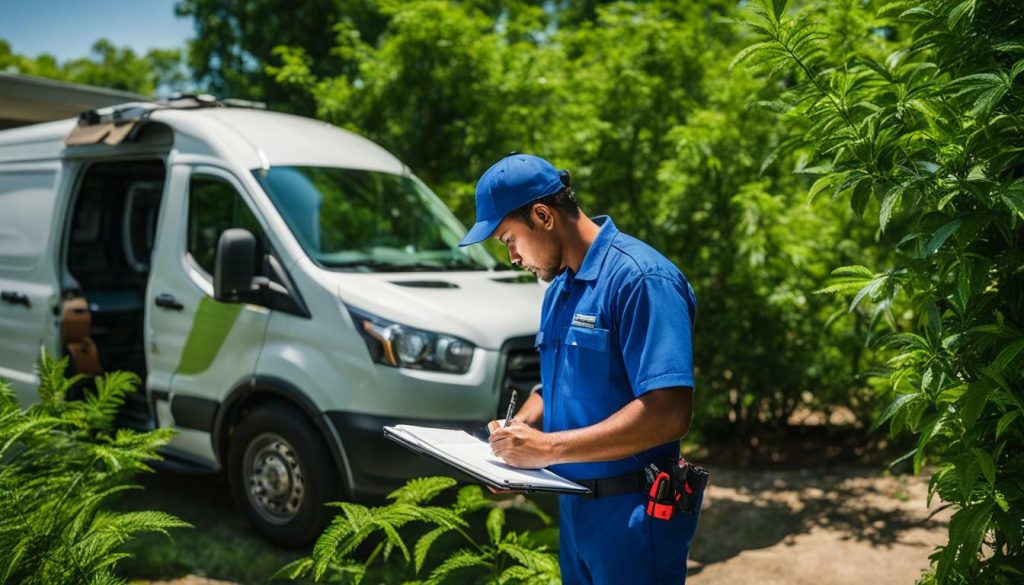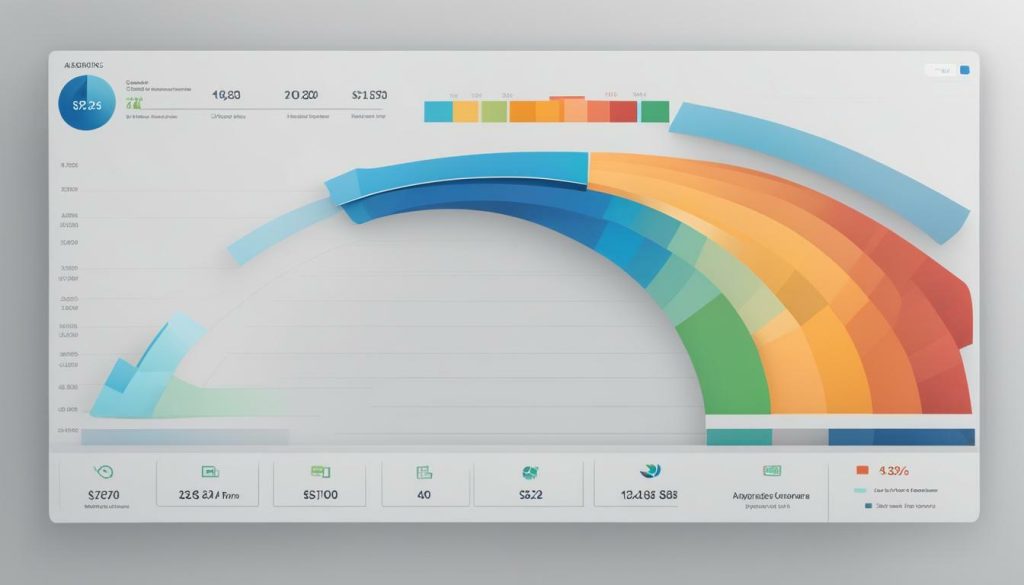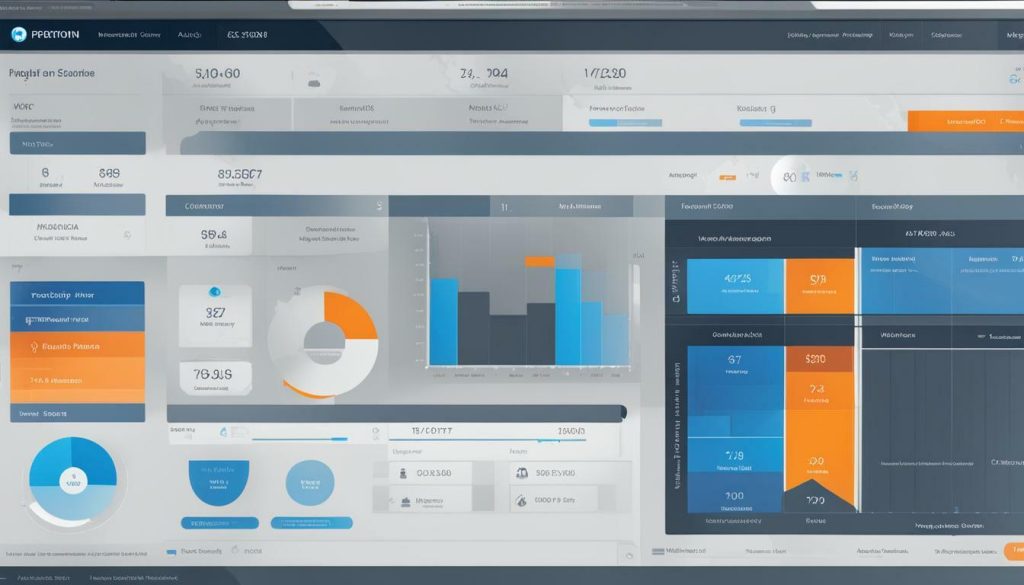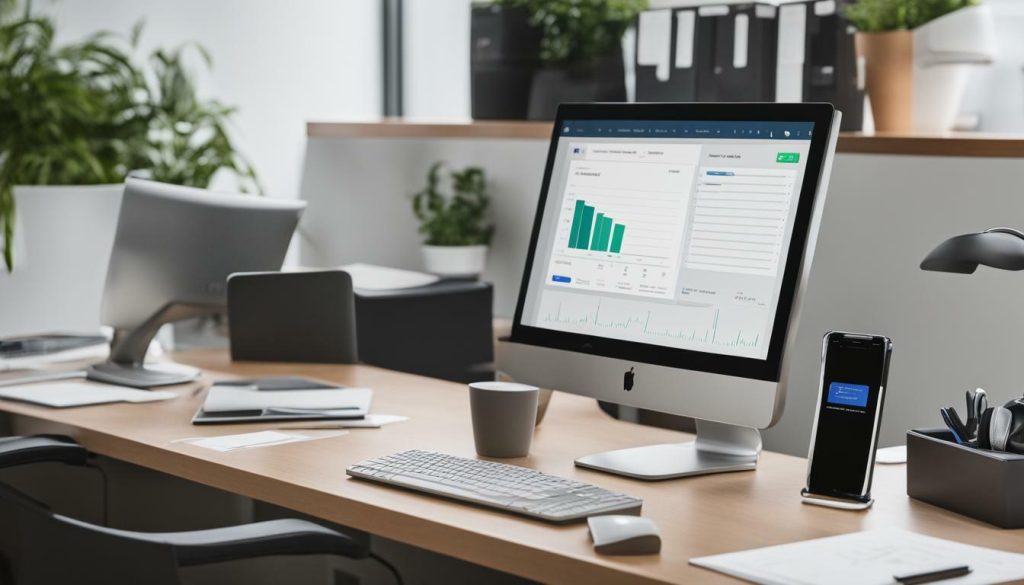Are you looking for ways to optimize your HVAC sales process and maximize your business’s potential? Discover the power of HVAC sales tracking and learn how to effectively manage your sales opportunities.
In the HVAC industry, tracking and managing sales opportunities is crucial for success. By implementing the right strategies and utilizing the appropriate tools, you can streamline your sales process, increase productivity, and drive profitability in your business.
Key Takeaways:
- Track communication with customers using a sales tracking app to ensure regular contact and enhance customer satisfaction.
- Leverage seasonal sales and marketing opportunities to generate leads and capitalize on peak times of winter and summer.
- Maximize efficiency with location-based tracking by using an app to pinpoint customers on a map and minimize drive time.
- Track key metrics such as lead velocity rate, lead response time, closing rate, customer acquisition cost, lifetime value of customers, lead acquisition cost, time per sale, and qualified lead rate to gain valuable insights into your sales performance.
- Implement HVAC sales software like ServiceTitan to streamline operations, improve sales calls, and organize customer information effectively.
The Importance of Communication Tracking with Customers
Consistent communication is key to nurturing customer relationships. Discover how a sales tracking app can help you stay in touch with your HVAC customers and provide exceptional service.
In the HVAC industry, building and maintaining strong relationships with customers is crucial. Effective communication tracking plays a vital role in ensuring customer satisfaction and loyalty. With a sales tracking app, you can easily keep track of all your customer interactions, including phone calls, emails, and service appointments. This allows you to stay organized and ensure that no customer communication falls through the cracks.
By using a sales tracking app, you can also promptly address any customer concerns or inquiries. You can set reminders to follow up on specific issues, ensuring that no customer is left waiting for a response. This level of responsiveness demonstrates your commitment to excellent customer service and helps build trust and loyalty.
Furthermore, a sales tracking app provides a centralized platform for storing customer information. You can access important details such as past service history, preferences, and notes from previous interactions. This enables your sales and service teams to provide personalized and tailored experiences to each customer, enhancing their overall satisfaction.
![]()
In conclusion, leveraging a sales tracking app is essential for effective communication tracking with customers. By utilizing this tool, you can stay in touch with your HVAC customers, address their needs promptly, and provide exceptional service. Start implementing a sales tracking app in your HVAC business today and see the positive impact it has on your customer relationships and overall business success.
Leveraging Seasonal Sales and Marketing Opportunities
Learn how to leverage seasonal sales and marketing opportunities to boost your HVAC business and drive sales during peak times of the year. The HVAC industry experiences fluctuations in demand throughout the year, with winter and summer being the busiest seasons. By strategically planning your sales and marketing efforts during these times, you can maximize your business’s growth potential.
Targeted Marketing Campaigns
One effective strategy is to launch targeted marketing campaigns that align with the seasonal needs of your customers. During the winter months, for example, customers often require heating system maintenance, repairs, or upgrades. By focusing your marketing efforts on promoting these services, you can generate leads and increase sales. Similarly, during the summer months, customers may be in need of air conditioning maintenance or installation. By tailoring your marketing message to highlight the benefits of these services, you can capture the attention of potential customers and drive sales.
Special Offers and Promotions
Offering special promotions and discounts during seasonal peaks can also help attract customers and generate leads. For instance, you could provide discounts on heating system tune-ups before winter, or offer bundled packages that include both heating and cooling services. By providing valuable incentives and showcasing the convenience and cost savings of your offers, you can entice customers to choose your business over competitors.

Building Long-Term Customer Relationships
While capturing new customers during seasonal peaks is important, it’s equally crucial to nurture and maintain long-term relationships with existing customers. By staying engaged with your customers throughout the year, you can encourage repeat business and referrals. Consider implementing customer loyalty programs or sending regular newsletters with helpful tips and reminders about seasonal maintenance. By demonstrating your commitment to customer satisfaction, you can foster trust and loyalty, leading to increased sales and a strong reputation in the HVAC industry.
By leveraging seasonal sales and marketing opportunities, you can generate leads, increase sales, and position your HVAC business for long-term growth. Remember to tailor your marketing efforts, offer special promotions during peak seasons, and prioritize building lasting customer relationships. With effective strategies in place, you can make the most of seasonal demand and maximize your sales potential.
Maximizing Efficiency with Location-Based Tracking
Streamline your operations by maximizing efficiency through location-based tracking. Discover how an app can help your sales reps and technicians optimize their routes and minimize drive time.
In the HVAC industry, time is of the essence. By utilizing a location-based tracking app, your sales reps and technicians can efficiently navigate through their daily tasks. The app allows them to pinpoint customers on a map, providing them with the most optimized routes to follow. This not only reduces unnecessary travel time but also ensures that they reach their destinations promptly.
By minimizing drive time, your team can focus on more valuable activities, such as meeting with customers and addressing their needs. Additionally, with the ability to track the location of your sales reps and technicians, you can quickly assign them new tasks or reroute them if necessary. This flexibility enhances your overall response time and customer service.
Optimizing Efficiency with Location-Based Tracking
With location-based tracking, you gain valuable insights into your team’s performance. By analyzing the data collected, you can identify patterns and trends, allowing you to make informed decisions to further enhance efficiency. For example, you may discover that certain areas have higher customer demand, enabling you to allocate resources accordingly.
Implementing location-based tracking also boosts accountability within your sales team. When reps and technicians are aware that their movements are being monitored, they are more likely to adhere to schedules and complete tasks promptly. This accountability leads to improved productivity and customer satisfaction.
Overall, the use of an app for location-based tracking is a powerful tool in optimizing sales operations in the HVAC industry. By streamlining routes and minimizing drive time, your team can focus on what matters most – delivering exceptional service and closing deals.

| Benefits of Location-Based Tracking | Benefits of an App for Sales Reps and Technicians |
|---|---|
| Minimizes drive time | Optimizes routes |
| Enhances response time | Improves accountability |
| Increases productivity | Allows for efficient task assignment |
| Improves customer service | Provides valuable performance insights |
Key Metrics for HVAC Sales Tracking
Gain a deeper understanding of your HVAC sales performance by tracking key metrics that provide valuable insights into your business’s effectiveness. By measuring and analyzing these metrics, you can make data-driven decisions and optimize your sales opportunities in the HVAC industry.
Lead Velocity Rate
The lead velocity rate measures how quickly your sales pipeline is growing. This metric shows the rate at which new leads enter your pipeline and can help you identify trends and patterns in lead generation. By tracking the lead velocity rate, you can adjust your sales strategies accordingly to maintain a steady flow of potential customers.
Lead Response Time
The lead response time measures how quickly your sales team responds to new leads. A fast response time is crucial for converting leads into customers, as it shows your commitment and responsiveness. By monitoring and improving your lead response time, you can increase your chances of closing sales and enhancing customer satisfaction.
Closing Rate
The closing rate measures the percentage of leads that your sales team successfully converts into customers. This metric reflects the effectiveness of your sales strategies and can help you identify areas for improvement. By tracking your closing rate, you can refine your sales process and increase your conversion rates.
| Metric | Definition |
|---|---|
| Lead Velocity Rate | The rate at which new leads enter your sales pipeline |
| Lead Response Time | The time it takes for your sales team to respond to new leads |
| Closing Rate | The percentage of leads that are successfully converted into customers |
| Customer Acquisition Cost | The cost of acquiring a new customer |
| Lifetime Value of Customers | The total value a customer brings to your business during their entire relationship with you |
| Lead Acquisition Cost | The cost of acquiring a new lead |
| Time per Sale | The average time it takes to close a sale |
| Qualified Lead Rate | The percentage of leads that meet the criteria to be considered qualified |
Customer Acquisition Cost
The customer acquisition cost measures the monetary investment required to acquire a new customer. By tracking this metric, you can evaluate the cost-effectiveness of your sales and marketing efforts. Lowering your customer acquisition cost can improve your profitability and ensure a positive return on investment.
Lifetime Value of Customers
The lifetime value of customers measures the total value a customer brings to your business during their entire relationship with you. This metric takes into account factors such as repeat purchases and customer loyalty. By understanding the lifetime value of your customers, you can focus on retaining and nurturing long-term relationships to maximize revenue.
Lead Acquisition Cost
The lead acquisition cost measures the cost of acquiring a new lead. This metric is crucial for assessing the efficiency of your lead generation strategies. By tracking your lead acquisition cost, you can identify the most cost-effective lead sources and allocate your resources accordingly.
Time per Sale
The time per sale measures the average time it takes to close a sale. This metric reflects the efficiency of your sales process and can help you identify bottlenecks or areas where improvements can be made. By reducing the time per sale, you can increase productivity and drive revenue growth.
Qualified Lead Rate
The qualified lead rate measures the percentage of leads that meet the criteria to be considered qualified. This metric helps you assess the effectiveness of your lead qualification process. By tracking your qualified lead rate, you can ensure that your sales team is focusing their efforts on high-quality leads, increasing the chances of successful conversions.

The Benefits of HVAC Sales Software
Discover the advantages of using HVAC sales software to streamline your operations, improve customer service, and drive sales growth. With the right software tool, like ServiceTitan, you can take your HVAC sales management to the next level. Let’s explore how this powerful tool can benefit your business.
Firstly, the ability to dispatch the right technicians to the right jobs is crucial for maximizing efficiency. HVAC sales software, such as ServiceTitan, enables you to assign and schedule technicians based on their expertise, availability, and proximity to customers. By optimizing technician allocation, you can minimize downtime and ensure prompt service, leading to improved customer satisfaction and loyalty.
In addition, implementing a standardized process for sales calls is essential for consistency and effectiveness. HVAC sales software allows you to create predefined scripts and checklists, ensuring that your sales team follows a structured approach. This standardized process enhances professionalism and helps your team deliver consistent messaging and provide accurate information to customers.
Furthermore, organizing customer information is crucial for delivering personalized and efficient service. HVAC sales software provides a centralized database where you can store customer details, service history, preferences, and more. This comprehensive customer profile equips your team with the information they need to tailor their approach, anticipate customer needs, and provide an exceptional experience.
Benefits of HVAC Sales Software:
- Efficient technician dispatching for prompt service
- Standardized sales process for consistency and effectiveness
- Centralized customer database for personalized service
By leveraging HVAC sales software like ServiceTitan, you can optimize your operations, enhance customer service, and drive sales growth. Take advantage of these benefits and stay ahead in the competitive HVAC industry.

Streamlining Sales Calls and Customer Information
Learn how to streamline your sales calls and effectively manage customer information for enhanced sales performance and customer satisfaction. In the competitive HVAC industry, efficient sales calls and organized customer information are essential for driving revenue and maintaining client relationships. By implementing a standardized process and utilizing an organized system, you can optimize your sales efforts and provide a seamless experience for your customers.
Start by establishing a standardized approach for sales calls. This involves creating a consistent framework for your sales team to follow, ensuring that each call incorporates the necessary steps and information. By defining a standardized process, you can minimize errors, increase efficiency, and improve the overall effectiveness of your sales calls.
In addition to a standardized process, effectively managing customer information is crucial. Implementing an organized system for storing and accessing customer data allows your team to have quick and easy access to important details. This includes information such as customer preferences, service history, and any specific requirements. By having this information readily available, your team can personalize interactions, address customer needs, and provide a high level of service.
To streamline sales calls and manage customer information efficiently, consider investing in an HVAC software tool. ServiceTitan, for example, offers features that can help you optimize your sales process. From automatically assigning sales calls to the appropriate technicians to providing a centralized database for customer information, these tools can enhance your sales management capabilities and boost customer satisfaction.

By streamlining sales calls and effectively managing customer information, HVAC companies can enhance their sales performance and ultimately drive greater customer satisfaction. Remember to prioritize a standardized process for sales calls and invest in the right tools to help you stay organized and efficient. With these strategies in place, you can optimize your sales opportunities and build long-lasting relationships with your customers.
Implementing Effective Sales Tracking Tools
Enhance your HVAC sales management by implementing effective sales tracking tools designed specifically for the industry. These tools can provide valuable insights and improve your overall sales performance. Whether you are a small business or a large enterprise, utilizing a sales tracking system or software can streamline your operations, boost productivity, and drive profitability.
One of the key benefits of using HVAC sales tracking tools is the ability to generate detailed reports and analytics. These reports can give you a comprehensive view of your sales pipeline, customer behavior, and the effectiveness of your sales strategies. By analyzing this data, you can identify areas for improvement and make data-driven decisions to optimize your sales process.
Another advantage of implementing sales tracking tools is the ability to organize and manage customer information effectively. With the right software, you can easily store customer details, track interactions, and access relevant information quickly. This allows you to provide personalized and efficient service to your customers, leading to higher satisfaction and increased repeat business.
Furthermore, some sales tracking tools offer additional features like lead management, task automation, and appointment scheduling. These features can help you streamline your sales team’s workflow, automate repetitive tasks, and ensure timely follow-ups with leads and customers. By maximizing efficiency and reducing manual work, your team can focus on what they do best – closing deals and driving revenue.
| Benefits of Implementing Effective Sales Tracking Tools: |
|---|
| Generate detailed reports and analytics |
| Organize and manage customer information effectively |
| Streamline workflow, automate tasks, and schedule appointments |
![]()
By incorporating these effective sales tracking tools into your HVAC sales management process, you can gain a competitive advantage, improve customer satisfaction, and drive growth in your business. Take the time to evaluate different options and choose the tools that best fit your business needs and objectives. With the right tools in place, you can optimize your sales opportunities and achieve long-term success in the HVAC industry.
Conclusion
By implementing HVAC sales tracking techniques and utilizing the right tools, you can optimize your sales opportunities, streamline your operations, and drive profitability in the HVAC industry.
To effectively track and manage your HVAC sales opportunities, it’s essential to keep track of communication with customers using a sales tracking app. This ensures regular contact and allows you to address any concerns promptly, leading to enhanced customer satisfaction.
Tracking sales seasonally and implementing targeted marketing efforts before the peak times of winter and summer can help generate leads and capitalize on the increased demand during these periods. By leveraging seasonal sales and marketing opportunities, you can maximize your revenue potential.
Maximizing efficiency is crucial for profitability, and location-based tracking can play a significant role in achieving this. By using an app to pinpoint customers on a map and minimize drive time, your sales reps and technicians can save time, reduce costs, and improve customer satisfaction.
Tracking key metrics such as lead velocity rate, lead response time, closing rate, customer acquisition cost, the lifetime value of customers, lead acquisition cost, time per sale, and qualified lead rate is essential for evaluating the effectiveness of your HVAC sales efforts. By analyzing these metrics, you can gain valuable insights and make data-driven decisions to optimize your sales performance.
Utilizing an HVAC software tool like ServiceTitan can significantly improve your sales management and operations. From dispatching the right technicians to creating a standardized process for sales calls and organizing customer information, this software can streamline your operations and enhance customer satisfaction.
Establishing a standardized process for sales calls and organizing customer information is vital for efficient sales management. By adopting these practices, you can improve your sales team’s effectiveness and provide a seamless experience for your customers.
In conclusion, by implementing HVAC sales tracking techniques and utilizing the right tools, you can optimize your sales opportunities, streamline your operations, and drive profitability in the HVAC industry. By tracking communication, leveraging seasonal opportunities, maximizing efficiency with location-based tracking, monitoring key metrics, and utilizing effective sales tracking tools and software, you can effectively manage and maximize your sales opportunities in the HVAC industry.
FAQ
How can I track and manage my HVAC sales opportunities effectively?
To track and manage your HVAC sales opportunities effectively, there are several tips and metrics to consider. First, it’s important to keep track of communication with customers using a sales tracking app to ensure regular contact. Additionally, tracking sales seasonally and marketing before the peak times of winter and summer can help generate leads. Maximizing time by location is another strategy, where sales reps and technicians can use an app to pinpoint customers on a map and minimize drive time. Other key metrics to track include lead velocity rate, lead response time, closing rate, customer acquisition cost, the lifetime value of customers, lead acquisition cost, time per sale, and qualified lead rate. Implementing an HVAC software tool like ServiceTitan can also help with dispatching the right technicians to the right jobs, creating a standardized process for sales calls, and organizing customer information. By implementing these strategies and tracking the relevant metrics, HVAC companies can better manage and maximize their sales opportunities.
Why is tracking communication with customers important for HVAC sales?
Building and maintaining strong relationships with customers is crucial in the HVAC industry. By tracking communication with customers using a sales tracking app, you can ensure regular contact, address any concerns promptly, and enhance customer satisfaction. This ultimately leads to increased customer loyalty and repeat business.
How can tracking sales seasonally help generate leads for HVAC sales?
Tracking sales seasonally allows HVAC companies to focus their marketing efforts before the peak times of winter and summer. By strategically timing marketing campaigns, companies can generate leads when customers are most likely to be interested in HVAC services, resulting in more sales and improved revenue.
How does location-based tracking maximize efficiency for HVAC sales and service teams?
By using an app to pinpoint customers on a map, sales reps and technicians can minimize drive time and optimize their schedules. This saves time, reduces costs, and improves customer satisfaction by ensuring timely service delivery. Location-based tracking also allows companies to allocate resources more effectively and increase productivity.
What are the key metrics to track for HVAC sales opportunities?
Key metrics to track for HVAC sales opportunities include lead velocity rate (the rate at which leads move through the sales pipeline), lead response time (how quickly leads are responded to), closing rate (the percentage of leads that result in a sale), customer acquisition cost (the cost of acquiring a new customer), the lifetime value of customers (the total value a customer brings to the company over their lifetime), lead acquisition cost (the cost of acquiring a single lead), time per sale (how long it takes to close a sale), and qualified lead rate (the percentage of leads that meet specific criteria and are considered qualified). Tracking these metrics allows companies to identify areas for improvement and make data-driven decisions.
How can HVAC software tools help with sales management?
HVAC software tools like ServiceTitan can significantly improve sales management and operations. They help with dispatching the right technicians to the right jobs, creating a standardized process for sales calls, and organizing customer information. This streamlines operations, improves efficiency, and enhances customer satisfaction by providing a seamless experience.
Why is a standardized process for sales calls and organized customer information essential for HVAC sales?
A standardized process for sales calls ensures consistency, professionalism, and efficiency in interactions with customers. It helps sales reps deliver a consistent message and follow a structured approach, leading to better outcomes. Organized customer information allows for easier access to important details, reduces errors, and improves customer service.
What are some effective sales tracking tools for HVAC companies?
There are various sales tracking systems, software, and tools specifically designed for the HVAC industry. These tools can provide valuable insights and improve overall sales performance. Some popular options include HVAC sales tracking tools, sales tracking software, HVAC sales reporting tools, and HVAC sales analytics platforms.




0 Comments